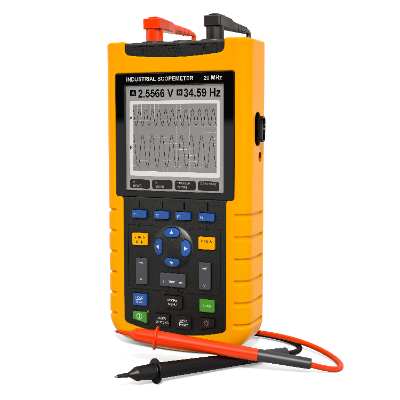0 Handheld Oscilloscope Manufacturers in 2024
This section provides an overview for handheld oscilloscopes as well as their applications and principles. Also, please take a look at the list of 0 handheld oscilloscope manufacturers and their company rankings.
Table of Contents
Categories Related to Handheld Oscilloscopes
What Is a Handheld Oscilloscope?

A handheld oscilloscope is a small oscilloscope designed for outdoor use and can be operated by batteries.
It is also called a handheld oscilloscope. An oscilloscope is a measuring instrument that displays changes in signal voltage in an electronic circuit as time-series waveform data. By reading the changes in this waveform and the magnitude of the amplitude, changes in the signal are measured.
Originally designed for use in laboratories and on factory production lines, these devices require high precision, high sensitivity, high-speed data processing, and other high performance features, resulting in a large chassis and high power consumption. On the other hand, oscilloscopes are also needed for use in the field where electronic equipment is installed for adjustment and repair of the equipment.
In this case, even if the performance is somewhat inferior, the oscilloscope must be small, lightweight, and battery-powered, eliminating the need for a commercial power supply. Handheld oscilloscopes satisfy these requirements. Portable oscilloscopes are generally smaller versions of the installation type oscilloscopes and are different from handheld oscilloscopes.
Uses of Handheld Oscilloscopes
As mentioned in the previous section, handheld oscilloscopes are used for waveform observation at the site where the equipment is installed. Because they are compact and do not require a power supply, they are easy to maneuver, easy to use, and increase work efficiency.
Also, because it is battery-powered, it is suitable for waveform observation of equipment in a floating state. For oscilloscopes that use a commercial power supply, it is recommended that the main unit be grounded to prevent electric shock. However, if the ground level of the device to which the oscilloscope is connected is floating, there may be a large potential difference between the two, which may damage the device or the oscilloscope.
On the other hand, if the oscilloscope is battery-powered, such a problem does not occur because the handy oscilloscope is also in a floating state. Furthermore, handy oscilloscopes are also used for personal electronics work because of their relatively simple functions and low cost. Similarly, they are easy to use in classes at educational institutions.
Principles of Handheld Oscilloscopes
There are two types of oscilloscopes: an analog type that uses the afterimage effect of a cathode-ray tube, and a digital type that converts the signal waveform to A/D and records it in memory.
Therefore, the principle of capturing signal waveforms is exactly the same as that of digital oscilloscopes. However, because they are small and battery-powered, there are various limitations in terms of functionality. The main limitations are as follows:
- Small waveform memory capacity
- Waveform sampling frequency cannot be increased to high speed.
- Limited accessories such as probes
- Limited number of channels (most models have 2-channel configuration, few have more than 2 channels)
- Complex trigger conditions cannot be set.
On the other hand, since they are battery-powered, the ground level can be set independently of the ground, as described in the previous section, so ordinary probes can be used even in situations where differential probes are required with ordinary oscilloscopes.
Types of Handheld Oscilloscopes
Miniaturized handheld oscilloscopes are available in the following types:
1. PC to Oscilloscope Type
This type of oscilloscope combines a digitizer function that converts signals to A/D and stores them in memory, and connects to a PC via USB to display signal waveforms on the PC's display. This type is generally simple and inexpensive, but it is not strictly speaking a handy device since a PC is indispensable for waveform observation.
2. All-In-One Type
This type is equipped with a display device and is capable of capturing and displaying signal waveforms by itself. The captured signal waveforms can be output to an external device via USB or a memory card, and the data can be analyzed using a PC.
In addition, the built-in rechargeable battery allows measurement without connecting to a commercial power source, as long as the battery is charged with an AC adapter. Some models can use commercially available alkaline batteries.
3. Type With Digital Multimeter Function
In addition to the functions of an oscilloscope, this type integrates the functions of a digital multimeter and a frequency counter. Although their individual functions are not as good as those of dedicated measuring instruments, they are extremely convenient, especially when brought to the site where the equipment is installed for measurement, since they have all the measurement functions in a single unit.
List of 0 Handheld Oscilloscope Manufacturers
*Including some distributors, etc.
Sort by Features
- Default
- Company Size: largest first
- Year Founded: oldest first
- Year Founded: earliest first
Handheld Oscilloscope Manufacturer Ranking
*Including some distributors, etc.Number of Employees
Newly Established Company
Company with a History
List of Handheld Oscilloscope Products
5 products are listed.
Wave Crest
Portable design SHS800X Hand Heldo oscilloscope
■ Characteristics -The oscilloscope, serial ligor and decoder, spectral analysis, data logger, multimeter functions are integrated to achieve conve...
Wave Crest
Uses semi-reflection LCD panel OWON HDS-I Handheld DSO Channel Insulation
■ Characteristics ・ Half -reflected LCD panel is used to ensure values and waveform visibility even in outdoor sunlight. ・ Realize perfect isol...
Wave Crest
Convenient design for mobile phones SHS1000X Hand Heldo oscilloscope
■ Characteristics ・ Insulated voltage: Catiii 600 VRMS, Catii 1000 VRMS -The oscilloscope, serial ligor / decoder, spectral analysis, data logger,...

